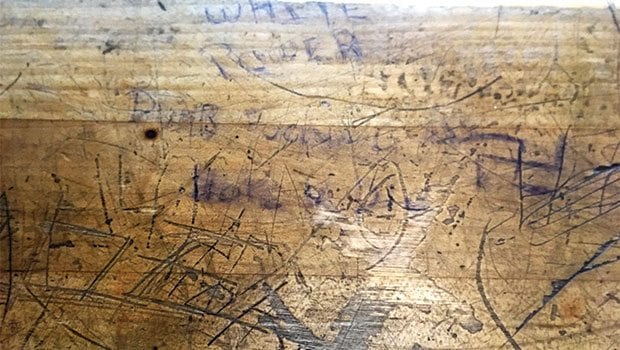Graffiti in MBTA station reflects national increase in race incidents

Some racist and anti-Semitic graffiti in South Boston’s Andrew MBTA Station appears to fit into a nationwide pattern of increasingly normalized bigotry that many people have raised alarms about in the Trump era. While it is currently unclear who wrote the graffiti or when, a Banner reporter spotted the messages last week and reported it to MBTA officials, who said they will conduct an investigation as per the agency’s policy.
On the outbound platform inside the Red Line subway station, there is a small swastika and the words “White Power” written in smudged pen on a bench. On the inbound platform, the words “White Power” are carved into another bench, seemingly in different handwriting. Someone appears to have attempted to scratch out the carved words. The markings appear alongside a host of other markings denoting various commuters’ thoughts: everything from regional pride (“Boston Strong,” “Southie”) to small town drama calling out neighbors by name to cries for help (“I want to shoot dope till I rot in the dirt”).
“In the last year, we’ve had a significant increase in the dissemination of hatred,” said Anti-Defamation League executive director Robert Trestan when reached for comment. (Trestan said he was not personally aware of the Andrew station example, and was speaking more generally.) “Sometimes it’s purely racial, sometimes it’s anti-Semitic, and sometimes it’s anti-gay. It tends to be in schools and public places. It’s part of a trend where hate and bigotry is seeping into the mainstream.”
While the bench markings are small in size and the existence of racist graffiti in Boston, especially South Boston, may not be exactly surprising to some given the city’s history, the specific symbols and language in these cases do appear to fit into a broader national rise of bigotry. In November, the FBI released a report showing a five-year high in hate crimes nationwide in 2016 — with a large uptick happening at the end of that year around the time of the election. Hate crimes from October to December 2016 were up by almost 26 percent compared to the same period of time in 2015. This adds to the pattern noted by various journalists and think tanks, such as the Southern Poverty Law Center, which documented almost 900 cases of bias-driven harassment or intimidation in the ten days following the 2016 presidential election.
The rise in such incidents have been tied to Donald Trump, who, among other things, famously lied that he “[knew] nothing about” former Ku Klux Klan Grand Wizard David Duke when the latter endorsed him in February 2016, and in August 2017 equated white supremacist and neo-Nazi marchers in Charlottesville, Virginia to anti-racist protesters. While the “White Power” and swastika graffiti at Andrew station did not reference Trump by name, other graffiti on nearby benches did. One read, “Go Trump, F* Hillary.”
Trump seen as catalyst
“It’s not right, everyone is equal as far as I’m concerned,” said commuter Bea Bausemer, a white retiree from Weymouth, when asked about the graffiti. She said she had not noticed it before. “America is supposed to be the mixing place where people can come over and get an education.”
“To me, it’s only started since Trump came around,” she added without being prompted to comment on the president. “Like what happened in Charlotte — he said it was both sides but it’s not. I’m sorry, he says he’s not prejudiced, but to me he’s the most prejudiced person I’ve ever heard.”
Another commuter, a middle-aged white man who declined to give his name, said he was unconcerned by the graffiti.
“I think the swastika is a beautiful symbol,” he said unironically when asked for his thoughts on the markings. “Adolf Hitler borrowed it — I think it’s a shame how the Nazis bastardized that symbol; it used to mean good luck.” While this is technically accurate — it was originally an ancient religious symbol from the Indian subcontinent — when the man was asked to comment on the graffiti in the context of what the symbol means in 21st-Century America, he said he remained unfazed.
“People have the right to free speech,” he said, adding that he “didn’t agree” with the graffiti message. “Thirty years ago, this wasn’t an issue,” he concluded as his train arrived. “Who’s stirring the pot?”
Another commuter had a simple response for the people behind the graffiti. “We’re all the same, what’s the fuss about?” said Rosemary Holness, a Jamaican American nurse’s aide from Boston. “We need more love. People need to love each other more.” She said that she had not noticed the graffiti before, but also noted that she also did not necessarily feel any more unsafe because of it. “In general, people are crazy — you don’t know who is who,” she said.
When the Banner approached the Andrew Station customer service manager about the graffiti, he quickly went to check it out, saying he would file a report with the MBTA police.
While he declined to give his name, the employee did say that such sentiments had a personal impact on him as a Vietnamese American person. “It bothers me but there’s nothing I can do,” he said. He said he experienced various forms of racism on the job “all the time,” calling it part of having a job dealing with the public. He has worked for the agency for more than 15 years.
The ADL’s Trestan said that the manager’s response was encouraging. “That’s the kind of thing that we want,” he told the Banner.
When the Banner followed up with the MBTA Transit Police the following day, an officer said the report would be referred to the MBTA Crime Analysis Unit. He said reports of this kind of graffiti were “not very common” but said when they do occur, the MBTA’s policy is to dispatch a transit officer to investigate it as well as put in a work request to remove it.






